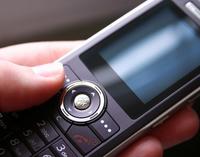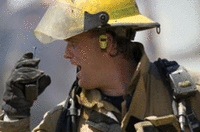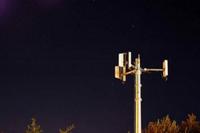-
Innovative disaster communication tech developed

Communication networks typically collapse when they are needed most — during and in the immediate aftermath of massive disasters; researchers have developed a — an innovative wireless system called LifeNet designed to help first responders communicate after disasters; LifeNet is a mobile ad-hoc network designed for use in highly transient environments that requires no infrastructure such as Internet, cell towers or traditional landlines
-
-
Ensuring reliable wireless alarm beacons for first responders
Wireless emergency safety equipment could save lives — if signals are transmitted reliably; NIST is studying interference between Personal Alert Safety Systems (PASS) with wireless alarm capability, and radio-frequency identification (RFID) systems
-
-
Thales’s Liberty LMR completes Department of Interior tests

Thales’s Liberty LMR has passed U.S. Department of Interior tests; the radio had earlier been approved for Law Enforcement and Tiers 1, 2, and 3; the company says the Liberty LMR, a software-defined radio solution, enables interoperability across all public safety bands, linking government agencies and first responders with a single portable radio
-
-
Alliance urges Congress to focus on D block allocation
The Public Safety Alliance (PSA) strongly encourages Congress to stay focused on legislation that would allocate the D Block to public safety for the creation of a nationwide, interoperable first responder broadband network
-
-
Anytime, anywhere communications across all devices enhances collaboration

Connecticut-based company offers anytime, anywhere communications across all types of devices — allowing public safety, emergency response, and select critical infrastructure entities to communicate and collaborate in the event of an emergency; the system may also be used by the military — in the field thousands of miles away — to alert, and provide information to in real time, domestic emergency agencies
-
-
Local emergency responders in Michigan could receive new radio system
Local emergency responders in Michigan could soon be receiving new communication equipment to connect with other nearby agencies; city councils in Grosse Pointes and Harper Woods are currently considering whether to purchase new radios to replace their aging 800 MHz system; a $485,000 DHS grant could help fund the purchase of the new radios which would cost more than $1 million to purchase
-
-
DHS allocates $25.5M for border communications
DHS recently announced that it would spend $25.5 million on additional security measures along the border; the money will be allocated to states as part of the Border Interoperability Demonstration Project (BIDP) which is designed as a one-time competitive grant program to develop innovative solutions that improve emergency communications for first responders and law enforcement agents; seven states including California, Maine, and Texas will receive grants
-
-
AT&T shows mobile cell towers for disaster communication

A new family of solutions from AT&T will make business, government, and public safety agencies better prepared for natural or man-made disasters; one of the new offerings, the “Fly-away” solution, packs a small cell site into a suitcase, offering first responders an easy-to-use, transportable system that can bring voice and data coverage to an area where disaster has knocked out communication channels
-
-
N.J. receives $5.7 million for seventeen police departments
Earlier this month the Department of Justice awarded New Jersey $5.7 million in grants to help seventeen local police departments; the grants are specifically aimed at purchasing surveillance equipment like closed-circuit cameras, gunshot detection systems, and mobile data centers; each city will receive either $250,000 or $500,000 based on the city’s size and violent crime; surveillance technology has already proven effective in helping New Jersey police departments track down and convict criminals; New Jersey’s attorney general is encouraging police departments to consider regionalizing and consolidating functions as the grants can be used to purchase equipment to create regional dispatch systems
-
-
Twitter and natural disasters: lessons from Japan
Researchers from Kobe City University of Foreign Studies surveyed and questioned Twitter users and tracked updates from people in the disaster-struck area on the social media site two weeks after the Tohoku earthquake and devastating tsunami of 11 March; Twitter was the only functioning communication tool immediately after the earthquake; the researchers found that there benefits for using Twitter, such as bringing information to people involved in a disaster and to those hoping to hear news; there was a downside, though: Twitter helped spread unverified rumors and misinformation, causing people to panic in areas where there was no reason to panic, thus making the work of rescuers and service authorities more difficult; one solution: have the government itself use Twitter to offer reliable information to all involved
-
-
NY emergency services communication not up to snuff
Nearly ten years after the 9/11 attacks, many police officers and first responders in New York still carry radios that cannot communicate with fellow emergency services personnel working for other agencies and jurisdictions; often, they use their personal cell phones during an operation; state lawmakers want this situation changed
-
-
Disaster-zone phone communication software available for free
Australian researchers developed software which enables mobile phones to communicate during a disaster; it will be freely available to the public by the end of the year thanks to the support of the Dutch NLnet Foundation; the software can be used on compatible mobile phone handsets to create an alternative “network” where conventional mobile phone coverage has been destroyed or does not exist
-
-
A cautionary tale of local information sharing
Calhoun County, Alabama recently spent $850,000 on interagency communications equipment, but so far only one local police department uses it and the system is the source of significant tension among law enforcement officials across the county; poor communication, proprietary databases, and high costs have effectively prevented the county from creating an information sharing system for local law enforcement; each police department uses laptops tied to different servers with different information on them, and though each system was designed to share information, none of the departments’ databases can communicate with one another due to proprietary data and non-compatible physical infrastructure
-
-
DHS grant buys gear for Ohio fire department
A DHS grant will allow the Lancaster, Ohio fire department to upgrade aging equipment and purchase a sophisticated new wireless tracking system; the new system will allow commanders to track firefighters on the scene and can send out distress signals if the firefighter becomes trapped or is impaired; the DHS grant covered $57,000 of the total $62,000; another $300,000 DHS grant will pay for a new fire truck to replace an aging truck that dates back to 1983; Lancaster has suffered from budget shortfalls and was forced to lay off firefighters
-
-
Law enforcement officials adapting to the cell phone age
Law enforcement officials are collecting more cell phone numbers for emergency alert phone lists as more people move away from land telephone lines; during emergencies land telephone lines are often knocked down and first responders do not have many cell phone numbers on file; emergency cell phone technology is rapidly improving with more accurate traces; 911 first responders hope to incorporate video, text, and photos in the future to better assess emergencies and communicate
-
- All
- Regional
- Water
- Biometrics
- Borders/Immig
- Business
- Cybersecurity
- Detection
- Disasters
- Government
- Infrastructure
- International
- Public health
- Public Safety
- Communication interoperabillity
- Emergency services
- Emergency medical services
- Fire
- First response
- IEDs
- Law Enforcement
- Law Enforcement Technology
- Military technology
- Nonlethal weapons
- Nuclear weapons
- Personal protection equipment
- Police
- Notification /alert systems
- Situational awareness
- Weapons systems
- Sci-Tech
- Sector Reports
- Surveillance
- Transportation
Advertising & Marketing: advertise@newswirepubs.com
Editorial: editor@newswirepubs.com
General: info@newswirepubs.com
2010-2011 © News Wire Publications, LLC News Wire Publications, LLC
220 Old Country Road | Suite 200 | Mineola | New York | 11501
Permissions and Policies
Editorial: editor@newswirepubs.com
General: info@newswirepubs.com
2010-2011 © News Wire Publications, LLC News Wire Publications, LLC
220 Old Country Road | Suite 200 | Mineola | New York | 11501
Permissions and Policies
